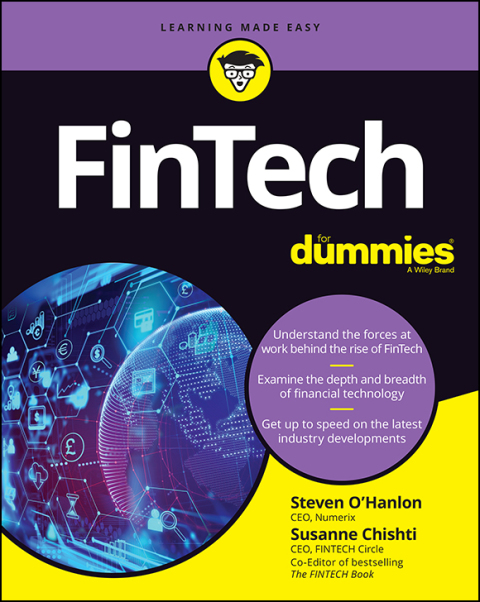Description
Efnisyfirlit
- Cover
- Introduction
- About This Book
- Foolish Assumptions
- Icons Used in This Book
- Beyond the Book
- Where to Go from Here
- Part 1: Getting to Know FinTech
- Chapter 1: Navigating the FinTech Landscape
- What Is FinTech, Anyway?
- Analyzing FinTech’s Dimensions
- Understanding What Has Changed in FinTech
- Highlighting the Size of Global FinTech
- Discovering a Few Important FinTech Terms
- Chapter 2: Understanding What’s Disrupting the Financial Industry (and Why)
- Providing Trust and Value
- Weighing Wall Street against Silicon Valley: Where Disruptors Live
- Examining the Role of BigTech
- Understanding Where the Disruptions Are Happening
- Looking for the Opportunities
- Chapter 3: The Role of Regulation in FinTech
- Supervising FinTech
- Examining Vendor Risk Issues
- Introducing the Regulators
- Investigating Regulatory Changes
- Highlighting RegTech Opportunities
- Part 2: Learning the Technology
- Chapter 4: Defining the Tech Underpinning FinTech
- Finding a Fix in FinTech
- Creating API Strategies
- Understanding Event-Driven Software
- Building on Agile: Microservices and More
- Bundling Efficiencies: Batch Processing
- Improving Data Management
- Working with CPUs and GPUs
- Choosing a Programming Language
- Chapter 5: Confronting the Compute Conundrum
- Determining Compute Requirements
- Making Sense of DApps
- Understanding Quantum Computing
- Chapter 6: Calling Up the Cloud
- Getting to Know the Cloud
- Developing an Optimal Cloud Strategy
- Understanding Privacy Compliance and Government Requirements
- Seeing How FinTech Helps with Cloud Strategies
- Chapter 7: Understanding Blockchain beyond Bitcoin
- Understanding the Basics of Blockchain
- Discovering How Blockchain Technology Works
- Looking at Blockchain’s Role in FinTech
- Chapter 8: Acclimating to the App Mentality
- Introducing Types of FinTech Apps
- Surveying the FinTech App Landscape
- Looking at the Nonretail Side of FinTech Apps
- Building a GUI Framework
- Establishing the Requirements Needed in the Development of an App
- Chapter 9: Breaking Down BI Tools
- Taking a Strategic Approach to BI
- Exploring BI Tools
- Choosing the Right BI Tools for FinTech
- Chapter 10: Reviewing the Role of Open Source
- Defining Open Source
- Looking at Open Source Development Processes
- Perusing the Pros of Open Source
- Considering the Cons of Open Source
- Evaluating Open Source Solutions
- Chapter 11: Grasping Data Management Fundamentals
- Looking at FinTech’s Role in Helping Companies Manage Their Data
- Understanding ETL: Extract, Transform, and Load
- Managing Market Data
- Dealing with Databases
- Maintaining Data Lineage
- Breaking Down Big Data
- Differentiating between Structured and Unstructured Data
- Comparing SQL and NoSQL
- Chapter 12: Adapting for Future Technologies
- Harnessing the Power of Artificial Intelligence
- Leveraging Machine Learning
- Making the Most of Chat Bots
- Checking Out Alternative Data Sources
- Part 3: Working with FinTech Companies
- Chapter 13: Deciding Whether to Build, Buy, or Partner
- Transforming Your Company Digitally
- Exploring Reasons to Build or Buy
- Finding a FinTech Partner
- Describing the Licensing Models
- Chapter 14: Managing Integration with Legacy Systems
- Understanding and Tackling the Challenges of Legacy Infrastructures
- Walking through the Technical Steps of Updating a Legacy System
- Simplifying Integration with Microservices Architecture
- Chapter 15: Preparing Your Team for a Successful Project
- Assembling a Transformation Team
- Setting Realistic Expectations and Timelines
- Supporting Change Agents
- Retaining Good Employees during Change
- Understanding Data-Driven Decision-Making
- Breaking the Silos
- Chapter 16: Investing in FinTech Companies
- Understanding the Players
- Navigating the Investor Landscape
- Conducting Due Diligence
- Evaluating a Company’s Growth Strategies
- Considering a Company’s Culture
- Chapter 17: Figuring Out the FinTech Endgame
- Bringing the Board Up to Speed on FinTech
- Looking into the Future of FinTech
- Identifying Industry-Driven Networks, Accelerators, and Incubators
- Mulling Over Mergers and Acquisitions
- Part 4: The Part of Tens
- Chapter 18: Ten Symptoms of Ailing Legacy Technology
- A Band-Aid Overload
- A Lack of Backward Compatibility
- Incompatibility with Other Systems
- Disparate Data
- Spreadsheet Risk
- Latency
- Increasing Demand for Support and Maintenance
- Short-Term Gains and Long-Term Pains
- A Shrinking Talent Pool
- Lost Market Opportunities
- Chapter 19: Ten Questions for Determining Whether to Build or Buy
- Is This Functionality Core to Our Business?
- Is the Application Unique?
- Which Approach Is More Cost-Effective?
- Should This Application Be Built?
- What Are the Risks of Building versus Buying?
- When Does Open Source Make Sense?
- When Does Building Make Sense?
- How Can We Accelerate a Build?
- When Does Buying Make Sense?
- How Do We Select a Vendor and a Product?
- Chapter 20: Ten Considerations When Using Open Source Technology
- Your Business Model
- Open Source Community Health
- Tech Support
- Security
- Code Audits
- Reliability
- Hidden Costs
- Updates and Upgrades
- Potential Hardware Impact
- Legal Considerations
- Appendix: Building a FinTech Company from the Ground Up
- Writing a Business Plan
- Developing a Prototype
- Operating Off the Grid
- Raising Capital
- ‘The future of Fintech post the Corona crisis?’
- Index
- About the Authors
- Advertisement Page
- Connect with Dummies
- End User License Agreement







Reviews
There are no reviews yet.